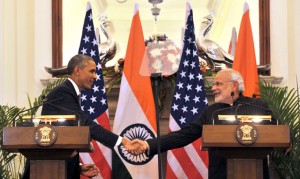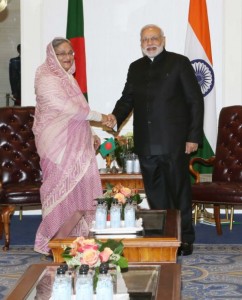The NDA government led by Prime Minister Narendra Modi has every reason to be satisfied with its performance on the foreign policy front since it came to office. The content, conduct and style of the country’s foreign policy bears the unmistakable imprimatur of Prime Minister Modi. He has led the charge from the front, establishing personal equations and developing rapport with several world leaders including Barack Obama, Shinzo Abe, Angela Merkel and recently also with Vladimir Putin. He has been able to enthuse and invigorate the Indian overseas communities like never before. This has created space for India at the high table at all global conferences and fora to discuss and evolve universal rules and laws on challenges confronting the international community like climate change, trade, finance and security.
Is PM Modi travelling too much?
Modi’s opponents charge that he spends more time outside the country than inside. Also, that he is interested in building up his own image rather than using the outreach for benefit of the country.
Although Modi did travel to 26 countries during 2015, these allegations don’t appear sustainable. Several visits undertaken were in connection with multilateral or regional meetings like G-20, BRICS Summit, India-Asean and East Asia Summits, Climate Change Summit, and UN Sustainable Development Summit. There were also some bilateral annual summits.
A welcome change that Modi has introduced is that he rarely, if ever, undertakes a single country visit. He combines many countries in the neighbourhood and travels to them together. This is a much more efficient utilization of time and resources.
Modi has reportedly instructed the Indian Foreign Office to limit his foreign visits during 2016 as he would like to focus more on domestic issues. In some ways, this is welcome. It would, however, be difficult to significantly reduce the number of his foreign trips as several of them are connected with pre-scheduled global or regional conclaves at which his presence would be mandatory.
Outlook 2016
Priorities of the government in 2016 will be the same as pursued over the last 19 months.
In the neighborhood, relations with Bangladesh are developing well. However, India should work assiduously to resolve the Teesta river water sharing issue. No forward movement can be expected till the Assembly elections in West Bengal are over later this year. Cooperation to promote trade and economic exchanges as well as control insurgency from Bangladesh should not slacken.
With Sri Lanka, efforts should continue to resolve outstanding issues relating to Indian fishermen, settlement of displaced persons and upgradation of bilateral FTA to CEPA.
India and Nepal will need to make concerted efforts to bridge the trust deficit that has crept into relations in recent months. Greater responsibility in this regard devolves upon India as it is the bigger partner. Nepal will, however, have to resist temptation to play the China card. Strong relations is a win-win situation for both countries. Nepal could emulate examples of Bhutan and Bangladesh, which enjoy warm and mutually beneficial relations with India. The visit by PM Oli to India next month will be an ideal opportunity to deepen understanding and partnership.
What to do with Pakistan?
Relations with Pakistan will continue to pose a challenge. India will need to adopt a multi-pronged approach. While talks on curbing terrorism and ensuring peace on IB and LOC should continue along with other issues, India should deliver a tough response to all terrorist actions emanating from Pakistan. All appropriate means should be employed so that Pakistan feels the pain of perpetrating violence on India. Simultaneously, India should continue to work with regional and international players like USA, Russia and China to apply pressure on Pakistan to stop abetting terrorists against India. India needs to work assiduously to further expand its national comprehensive strength including military capabilities to respond effectively to all malevolent designs from Pakistan.
Afghanistan will test South Block’s diplomatic skills. Modi has unequivocally asserted our strong interest in a stable, independent and democratic Afghanistan through his thoughtful and bold address to the Afghan Parliament in Kabul on 25th Dec, 2015. India needs to engage regional actors like Russia, China, Central Asian States, Iran and Pakistan to ensure stability, security, peace and prosperity in Afghanistan.
US, China & Japan
The US will provide a huge opportunity to further invigorate bilateral ties. Potential will lie in areas of defence acquisition and progressive indigenization, capital and technology infusion, clean energy, education, agriculture and strengthening strategic understanding and cooperation. India should persuade Washington to actively support India in its quest of UNSC permanent membership as well as membership of NSG and other export control regimes, and APEC.
China will present a formidable challenge. Policy of cooperation and competition will need to continue with forceful articulation of our core interests like Kashmir and border dispute. India, while enhancing its economic and military power, will need to strengthen its partnership with countries like USA, Japan, Australia, ROK and ASEAN to ensure that China evolves into a peaceful and responsible member of the international community. This is particularly relevant in the context of ensuring freedom of navigation, maritime security and resolution of South China Sea dispute through dialogue and in accordance with principles of international law.
2016 will provide valuable opportunities for significantly upgrading our ties with our time-tested ally, Russia. Modi’s recent visit to Moscow provided a significant boost to our multi-faceted bilateral ties. President Putin will visit India twice during this year and potential should be fully utilised to revive our relations in all fields. Russia is a valuable partner in ensuring security and stability in Afghanistan as well as promoting connectivity with Central Asia inter-alia through the mechanisms of SCO and EEU.
Ties with Japan have emerged as a bright spot and were given a huge upgrade during Modi’s visit to Japan in 2014 and return visit of Shinzo Abe last month when the momentous civil nuclear deal and defense cooperation agreements were inked in addition to decision to construct the shinkansen high-speed train from Mumbai to Ahmedabad. Japan’s participation in the Malabar exercises with India and USA re- emphasizes the strategic content of our rapidly expanding ties.
Relations with ASEAN can be expected to see a big move forward in trade and economic cooperation; promoting connectivity through the tri-lateral highway network from North-East India via Myanmar to Thailand and beyond; progress on Kaladan multi-modal transport network; completion of negotiations in the Mega Regional Comprehensive Economic Partnership Agreement. Myanmar will need special focus as Aung San Suu Kyi starts playing a more decisive role in conducting political and economic affairs of the nation. Myanmar occupies a unique place in our ”Act East Policy” as an economic gateway to Asean as also to ensure security for our North-Eastern States.
Modi’s travels: 2016
2016 is expected to see the first visit by an Indian Prime Minister to Israel. This will help to bring bilateral ties out of the closet and establish them on a firm, normal footing. Modi could also travel to Saudi Arabia, Iran and Egypt. This will build on the highly productive visit to UAE last year. Recent worsening of relations between Saudi Arabia (and some others) with Iran does not augur well for the region or for India. India could use its political capital to promote peace and understanding in the region.
Modi will travel in 2016 to China to participate in the G-20 Summit; to Washington DC for the Nuclear Security Summit; to Laos for the Asean plus India and EAS; to Venezuela for the NAM Summit; to Brussels for the India-EU Summit, probably on way back from Washington DC; to Pakistan for the SAARC Summit, and a few more. SCO Summit in Tashkent, bilateral annual summit in Japan, UNGA Session in New York etc could also witness Modi undertaking foreign tours. In addition, he could also visit South Africa to give a concerted push to his Africa policy, successfully launched with the 3rd India-Africa Forum Summit attended by leaders and representatives from all 54 African States.
Challenges in dealing with China, Pakistan, Nepal, Afghanistan and the Maldives as well as issues of terrorism will continue to test the political, strategic and diplomatic skills of the Indian establishment. At the beginning of 2016, however, New Delhi finds itself better equipped to confront these challenges with confidence and self-assurance than it has for many years in the past.
 (Ashok Sajjanhar is a former ambassador of India and a commentator on foreign policy issues. This article has been written exclusively for India Writes Network)
(Ashok Sajjanhar is a former ambassador of India and a commentator on foreign policy issues. This article has been written exclusively for India Writes Network)
Author Profile
- India Writes Network (www.indiawrites.org) is an emerging think tank and a media-publishing company focused on international affairs & the India Story. Centre for Global India Insights is the research arm of India Writes Network. To subscribe to India and the World, write to editor@indiawrites.org. A venture of TGII Media Private Limited, a leading media, publishing and consultancy company, IWN has carved a niche for balanced and exhaustive reporting and analysis of international affairs. Eminent personalities, politicians, diplomats, authors, strategy gurus and news-makers have contributed to India Writes Network, as also “India and the World,” a magazine focused on global affairs.
Latest entries
 DiplomacyJanuary 5, 2026India walks diplomatic tightrope over US operation in Venezuela
DiplomacyJanuary 5, 2026India walks diplomatic tightrope over US operation in Venezuela India and the WorldNovember 26, 2025G20@20: Africa’s Moment – The Once and Future World Order
India and the WorldNovember 26, 2025G20@20: Africa’s Moment – The Once and Future World Order DiplomacyOctober 4, 2025UNGA Resolution 2758 Must Not Be Distorted, One-China Principle Brooks No Challenge
DiplomacyOctober 4, 2025UNGA Resolution 2758 Must Not Be Distorted, One-China Principle Brooks No Challenge India and the WorldJuly 26, 2025MPs, diplomats laud Operation Sindoor, call for national unity to combat Pakistan-sponsored terror
India and the WorldJuly 26, 2025MPs, diplomats laud Operation Sindoor, call for national unity to combat Pakistan-sponsored terror











